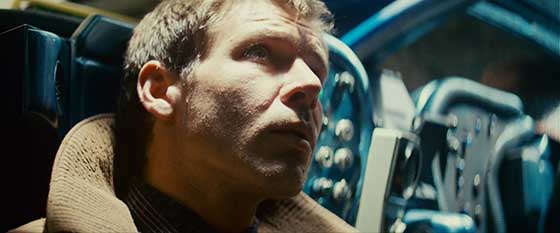
Blade Runner (1982) is a difficult film for me to see with new eyes. I need squishy new Replicant eyes designed by Hannibal Chew. On the big screen I’ve watched the theatrical edition (with a college homecoming ball blasting music loudly through the thin walls of the repertory theater), the 1992 Director’s Cut (at the appropriately baroque Oriental Theater in Milwaukee, which looks a bit like the Bradbury in the film), the Workprint (at Seattle’s Neptune Theater circa 1999), and the recent Final Cut, in Chicago. Like so many people, it was Blade Runner that introduced me to Philip K. Dick, an obsession that led to tracking down as many of his novels as I could – no easy feat in the 90’s, when he was mostly out of print. In high school I wrote and illustrated my own Choose Your Own Adventure-style Blade Runner book for my friends to play. I played the computer game, bought the soundtrack and the letterboxed VHS tape (back when letterboxing was something special, and a word people used), was wowed by the revelation of the Director’s Cut (how a single shot of a unicorn could act like a decoder ring), and when I saw the Workprint, got absurdly enthusiastic over a few seconds of dancing women in hockey masks, because it was new and therefore awesome. The 2007 Blu-Ray release and all its extras may be taken for granted in years to come as the content is appropriated onto new, likely digital platforms, but for longtime fans like me it was an embarrassment of riches, containing all the versions of the film (including the International Cut), a three-and-a-half hour documentary, and more new footage than I’d ever hoped to see. You keep turning Blade Runner incrementally and more facets reveal themselves. Ridley Scott created a three-dimensional world littered with minutia, borne out by the new footage that showed just how much of Los Angeles 2019 there was to explore. (Yes, 2019. We still have four years to get Spinner cars zipping past towering Enjoy Coca-Cola vidscreens. Don’t worry, it will happen.) So it’s possible to see all this with new eyes. Scott did all the work he needed to make a film that holds up to as many viewings as you can throw at it.
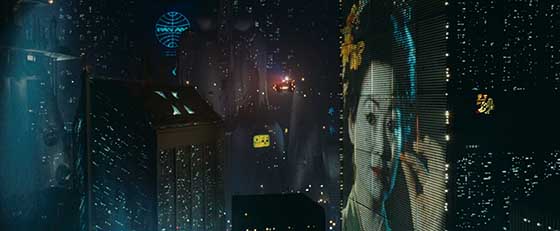
Los Angeles 2019, as designed by futurist Syd Mead.
It helps that the film is so unique, by which I mean it is deeply eccentric and sometimes deliberately off-putting. Scott wants to immerse you in a future that is overwhelming, so you feel like a time traveler adjusting to a new language (shades of A Clockwork Orange), finding the familiar – 20th century name brands like Coke, Pan Am, Atari; fashions harkening to the 1930’s and 40’s; the conventions of a police detective thriller – in a jarringly new context, a bit New Wave, a bit punk, a bit of the French Metal Hurlant comics, a bit Philip K. Dick. (It should be noted that beneath all these layers of inspiration, the film only bears a passing resemblance to the source novel Do Androids Dream of Electric Sheep?, PKD in a palimpsest.) Okay, new eyes: the opening credits, have you noticed how bland they are? Deliberately. The font is not “futuristic” (the iconic font style used in the poster art, which I recently saw appropriated into an ad for an auto body repair shop of all things, appears nowhere in the film). You might be watching any drama or thriller from the early 80’s. But the music, by Vangelis (Chariots of Fire), sounds like whalesong and thunder. Immediately your brain reels from the disconnect: where am I exactly and what’s in store? Explanatory text finally rolls up the screen while the score dissolves into atonal electronic sounds. The premise is explained, the only example of hand-holding you’ll get in this film. That is, unless you’re watching the theatrical cut with its overkill of narration, and which still has its fans; and that’s fine, but to me this is a film about isolation, and the more isolated you are as a viewer, the better. Here comes the cynical line at the end of our text: “This was not called execution. It was called retirement.” Immediately the emphasis is placed on one of the film’s main themes: the businesslike dehumanization of the Replicants. Then – BAM. These deliberately subdued titles explode into sensory overload. We’re in Los Angeles 2019, and there is no ground beneath our feet. We’re soaring through rusty skies in a world that looks like Hell, towering flames belching up from smog and smoke, while flying cars zip past. We cut to an extreme close-up of an eye, free of context, but reflecting that landscape. This isn’t Star Wars, and from here on out, there will be no hand-holding. Draw your own map, find your own meaning.
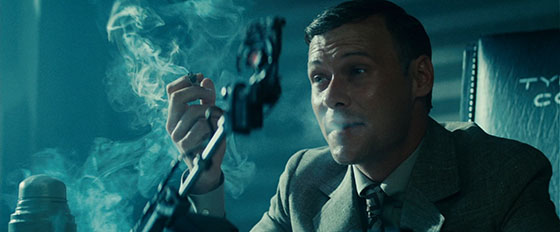
Morgan Paull as Holden, a Blade Runner.
Scott uses this technique a few minutes later, cutting abruptly to his special effect-laden miniatures and thrusting you deeper into future Los Angeles. But this time his cut comes after the murder of Blade Runner Holden (Morgan Paull, Fade to Black) by Replicant Leon (Brion James, 48 Hrs.) – it happens so quickly that I should say it happens during Holden’s murder, while audiences are still jumping out of their seat. All this is considerably muted to me now through familiarity, but I have to remind myself that when I first saw Blade Runner, it was an almost unbearably intense experience. I dreaded the moments of violence; Scott was coming off Alien (1979) and this film is most certainly a companion piece, taking place in a similarly nightmarish and brutal futuristic world. Going back to Holden – I always notice how much Morgan Paull’s performance seems modeled on Harrison Ford’s, but this time I make the conscious decision to not let that go. What’s really going on with this casting, and the way Paull is directed to act? They have a similar delivery, sneer of sarcasm, and a way of leaning back and studying their subject, withholding their opinions. Of course, they’re both Blade Runners, and they’re jaded. Assuming that Ford’s Rick Deckard is a Replicant (and – I know – some of you resist this), what if Holden is one too? They even look uncannily alike, as though Paull is acting as Ford’s stand-in. Were they grown from the same DNA, only slight variations allowed so they can fool themselves into thinking they’re human? I’m sure others have conjectured this, right?
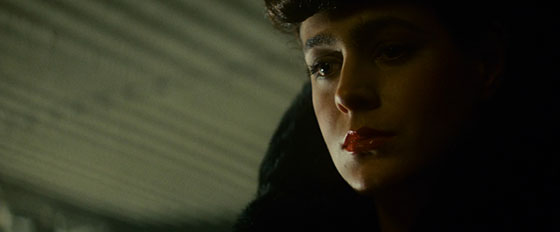
Rachel (Sean Young), a Nexus-6 Replicant coming to grips with her identity.
I write in my notebook ATMOSPHERE, in capital letters and underlined. This is a film of atmosphere and detail, and the reason I keep coming back to it, apart from its mysteries, is the rainy, noirish, gorgeously lit everything of this landscape. Upon the film’s release, many critics held that against the film: yes, it’s pretty and the special effects are good, but it has no soul, no likable characters – or variations to that effect. Critics treated it as though it were one of the Replicants: you are a pretty simulacrum, but you are not a living thing. Those critics are always nagging at me, their voices echoing out of the past whenever I watch the film. I don’t believe them, but I can still hear them. Yet couldn’t that complaint be a positive read of the film too? When Sean Young stares out of the shadows, her pupils lit with a faint amber glow that we see, at various points, in almost all the Replicants, Scott is empathizing with that gaze. Again, this is meant to be an isolating film. That’s a valid technique, Nagging Critic Voices in My Head From 1982; not everything with Harrison Ford must be The Empire Strikes Back. For the Replicants led by Roy Batty (Rutger Hauer, being effortlessly extraordinary in every moment), the real “Off World” is Los Angeles. Like “standard pleasure model” Pris (Darryl Hannah, Splash) sleeping in the rubbish and wandering the streets dressed like a punk hooker, the Replicants are dangerous but they’re also frightened and alone. They know they’re going to die, and despite Batty’s scheme to extend their lifespan, ultimately there’s nothing he can do to stop it. Scott has to get that desperate and lonely feeling across in every shot, and if the film makes you uncomfortable, it happens to be succeeding. Of course, their struggle is also the human one, as explicitly stated in the film. Both science fiction and fantasy, at their best, engage with familiar human struggles by recasting them into new concepts. It is a genre of ideas, but the ideas should be tied to the human, and even in Blade Runner, a film seen through the Replicant eyes designed by Hannibal Chew (James Hong, Big Trouble in Little China), the stakes are ours, because the film is asking what really separates us from these androids. Wait, here’s another criticism which I just read on a message board. Blade Runner is “boring.” I have no time for you, go away.
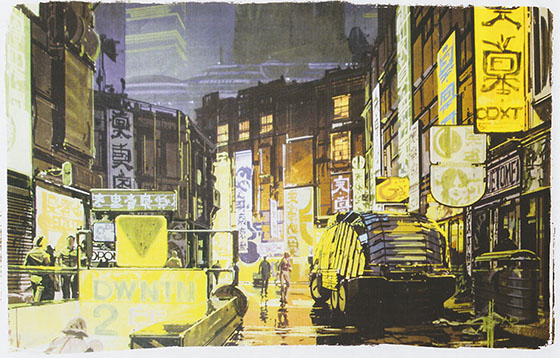
Syd Mead concept art.
Looking back on my notes from last night, what else have I got? “VID PHON.” All right, that’s not an idea, that’s just me writing down that the phones are called “VID PHON.” “Tyrell Corp – shimmering golden light.” Oh yeah. First of all, I always love that shimmering golden light in the offices of Nexus-6 designer Eldon Tyrell (Joe Turkel, The Shining), which makes it look like they’re in a golden aquarium. But when he touches a button and the windows begin to automatically tint, crawling down like shades, this time I noticed that all that was left was a single blue shaft of horizontal light: what most of the film looks like. Shafts of light are Scott’s trademark, of course, just as much as J.J. Abrams is often accused of violation of some unwritten lens flare rule. Their use in Blade Runner seems especially apt because the film consciously evokes film noir, and is often the first film mentioned when people write of neo-noir. Young, with her hair done up like a 40’s femme fatale, often stands at a pose with one hand on her hip while the trenchcoated Ford regards her with skepticism; this is the stuff of Raymond Chandler. But Young, with her slender limbs and sharp angles, also looks like a doll – like one of those toys piled up in the apartment of J.F. Sebastian (ubiquitous character actor William Sanderson). Let’s see, back to the notebook: “Rachel’s glowing eyes through the smoke.” Yep, got that, and have seen it many times before. “Never properly explain animals.” No, that’s not true; I mean, sure, it’s a much larger part of Dick’s novel, but the scarcity of animals is mentioned now and then in the film. Hm, that was the last note I wrote. I guess I just got lost in the film after that, and watched it until the ending credits were over. No “new eyes” at that point, just enjoying the film all the way to tears-in-the-rain. Damn the god of biomechanics. Maybe on my next visit to L.A. 11/19.
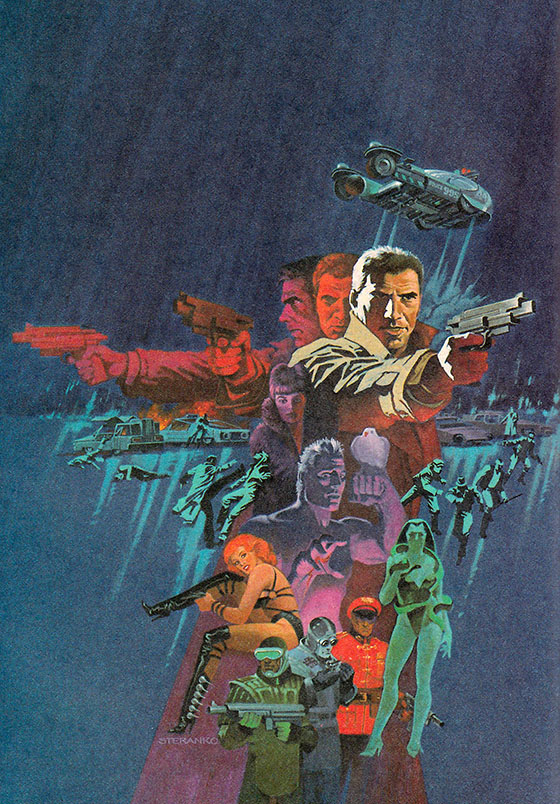
Jim Steranko art for the Marvel Comics adaptation.









